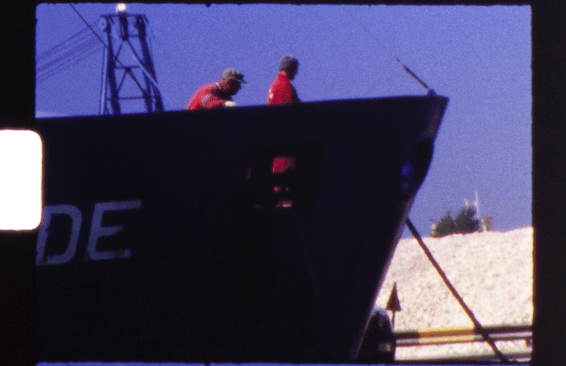- In September 2021, Bruno Delgado Ramo travelled to Toronto to work at the LIFT (Liaison of Independent Filmmakers of Toronto) facilities on his project Frame Manoeuvres to Port, having been selected to enjoy the International Artistic Residency for Cinematographic Creation promoted by (S8) together with AC/E and LIFT. These are some of his notes on exploring and discovering the port area of the Canadian city during his stay.

I made my first visit to the Port Lands (the port of Toronto and its surroundings) on foot. During the walk, I realised that if I intended to make several expeditions of this kind (on which I was not going to just one location but several on the same day) carrying the equipment, which finally added up to a hefty weight (Bolex H16, set of lenses, matte box, heavy tripod), then I needed a vehicle. I bought a second-hand bicycle through Kijiji, a classified ads website. My first tour of the Port Lands on foot also led me to understand another important factor in carrying out the project: the port of Toronto was at a low moment, apparently in decline. I only spotted one industrial-type ship dropping anchor, while the port area was packed with commercial buildings and luxury housing complexes that were new or under construction. Practically all the craft were pleasure boats. This first impression about the state of the port of Toronto was confirmed when I began to study the activity and movements of large vessels on the website marinetraffic.com. This website gives updated information about the position of most craft, which must be public, displayed on a geographic browser. On the first few days, seeing this unexpected inactivity in the port of Toronto, I analysed the movements of ships by expanding my study area beyond Toronto Bay. I discovered two areas with bustling activity: Hamilton Bay and Welland Canal. Hamilton is the main port in Lake Ontario, lying at the westernmost end of the lake, 70 km from Toronto. Ships gain access to the bay through the short Burlington Canal.
The Welland Canal, on the other hand, connects Lake Ontario with Lake Erie. The mouth of the canal leading to Ontario is on the southern shore of the lake, 130 km by road from Toronto. During this research and monitoring work, I also realised that whereas in Spain the port pilots in each city are grouped into small companies, in Canada they are grouped into macro-companies that provide services to several cities. In the Spanish cities that I passed through from the outset of the project (A Coruña, Bilbao and Seville), the pilot boats were easy to locate, as well as their facilities, since the information about each port’s pilot company is published on their websites. In Canada, however, I found a completely different picture. In fact, marinetraffic.com gave no information about pilotage vessels in Canada.
[…]
On my first trip to Hamilton Bay, I mainly explored the Burlington Canal and its vicinity. It is a relatively short canal with docks on both sides, only one of which is accessible to the public. Three vehicle traffic bridges cross it, two of which are big ones, with an imposing height. The oldest of the three is actually a lift-bridge and is much smaller. Its deck rises parallel to the canal’s water surface along two towers. These ascents and descents occur every time a vessel of sufficient size has to sail through the canal. During the filming, I explored different possible visual and structural relationships between the procedures tested with the Bolex and the movements of the bridge deck, as well as the corresponding counterweights. I also found various harbour elements on the canal dock that I could work with, such as a ladder . From this first trip onwards, I began to create an in-camera montage, interspersing the recordings on location with the images taken in the LIFT room.
The trips I made along the Welland Canal were the most demanding: it is a 43 km-long canal and the nearest railway station, St. Catharines, is 10 km away. On top of this, many stretches of the canal’s banks are fenced-off from a considerable distance and therefore not accessible. Although one can consult the information on the times each craft passes through each lock every day, it is always inaccurate. Hence, my exploration of the scenery had to take into account calculations and predictions of the ships’ locations. The lift bridges I found over the canal allowed me to continue the investigations I was carrying out in Hamilton.
Along with these two expeditions to Hamilton and the other two to the Welland Canal, I made several to the Toronto harbour area and another to Ward’s Island.
Bruno Delgado Ramo





